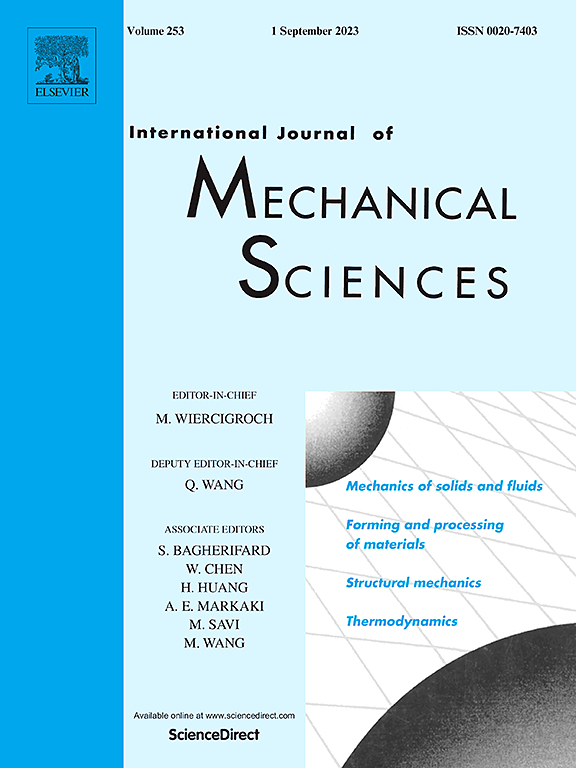Deposition mechanism of microscopic impacting droplets on flexible porous substrates
IF 7.1
1区 工程技术
Q1 ENGINEERING, MECHANICAL
International Journal of Mechanical Sciences
Pub Date : 2025-02-07
DOI:10.1016/j.ijmecsci.2025.110050
引用次数: 0
Abstract
Flexible and breathable porous pressure sensors are gaining attention due to their potential in wearable devices for human motion monitoring. The controllable deposition and transport of droplets on porous surfaces are critical for achieving high - conductivity printing in flexible and wearable sensors, as well as in electronic applications. Due to the intricate microstructure of porous layers, accurately dynamically tracking alterations in droplet morphology and the detailed characterization of multiphase-coupled transport present significant challenges. To address these issues, this study employs a microscopic multiphase-coupled transport dynamics model based on the volume-of-fluid smoothing correction and the Kistler dynamic contact angle model (VOFS-KCA). The aim is to investigate the evolution of droplet transport on both the external surface and internal pore spaces of porous media. Furthermore, it reveals the correlation between the structural characteristics of porous media and the mass transfer process in multiphase flow. Results show that the wettability of porous surfaces is a pivotal factor in droplet clusters' dispersion and mobility. The effect of porosity on droplet penetration is nonlinear. Appropriate porosity is conducive to droplet penetration on the porous surface, while excessive porosity leads to lateral diffusion in the cavity. A smaller fiber diameter leads to an approximately circular and uniform distribution of droplets on the porous surface and reduces permeability, which is conducive to maintaining the linewidth of the printed circuit and improving the conductivity. This study systematically explores how surface wettability, porosity, and fiber structure affect droplet dispersion and infiltration, providing new insights into the design of high-performance porous systems. This work lays the foundation for the high-precision manufacturing of flexible sensors with porous surfaces, with applications in energy storage, filtration, and biomedical systems.

求助全文
约1分钟内获得全文
求助全文
来源期刊

International Journal of Mechanical Sciences
工程技术-工程:机械
CiteScore
12.80
自引率
17.80%
发文量
769
审稿时长
19 days
期刊介绍:
The International Journal of Mechanical Sciences (IJMS) serves as a global platform for the publication and dissemination of original research that contributes to a deeper scientific understanding of the fundamental disciplines within mechanical, civil, and material engineering.
The primary focus of IJMS is to showcase innovative and ground-breaking work that utilizes analytical and computational modeling techniques, such as Finite Element Method (FEM), Boundary Element Method (BEM), and mesh-free methods, among others. These modeling methods are applied to diverse fields including rigid-body mechanics (e.g., dynamics, vibration, stability), structural mechanics, metal forming, advanced materials (e.g., metals, composites, cellular, smart) behavior and applications, impact mechanics, strain localization, and other nonlinear effects (e.g., large deflections, plasticity, fracture).
Additionally, IJMS covers the realms of fluid mechanics (both external and internal flows), tribology, thermodynamics, and materials processing. These subjects collectively form the core of the journal's content.
In summary, IJMS provides a prestigious platform for researchers to present their original contributions, shedding light on analytical and computational modeling methods in various areas of mechanical engineering, as well as exploring the behavior and application of advanced materials, fluid mechanics, thermodynamics, and materials processing.
 求助内容:
求助内容: 应助结果提醒方式:
应助结果提醒方式:


